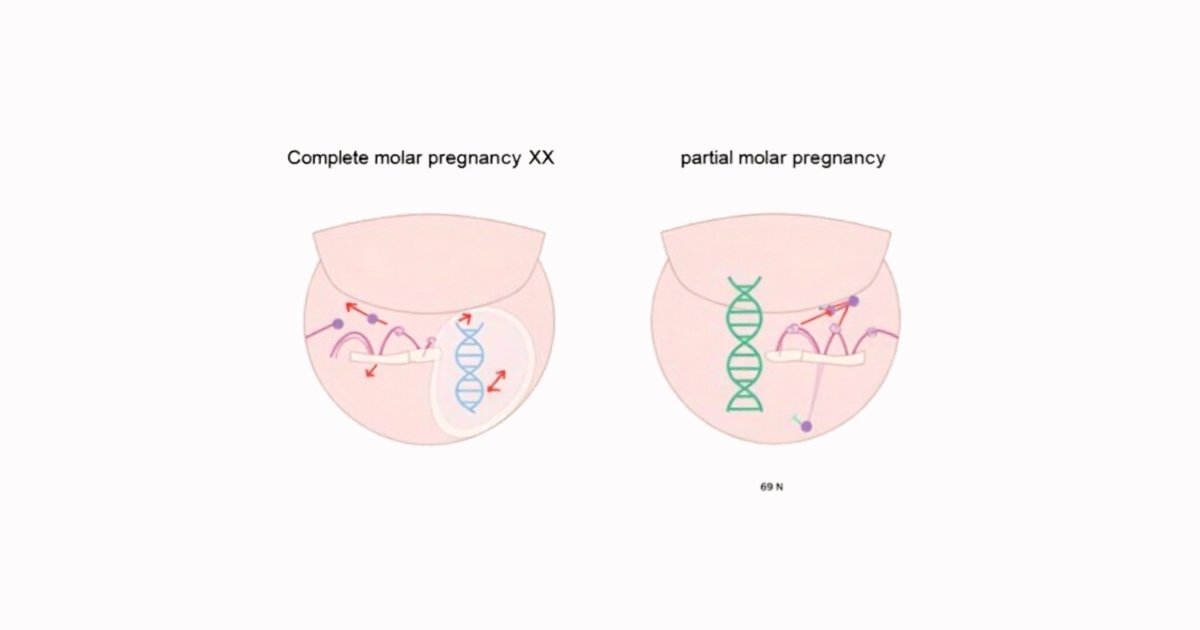What Is a Molar Pregnancy?
Molar pregnancy is a serious but often misunderstood pregnancy complication that any woman may face during her reproductive years. Commonly referred to as “grape pregnancy” due to its appearance, it results from a genetic error during fertilization. Instead of a normal pregnancy, fluid-filled cysts resembling grape-like clusters develop inside the uterus. This condition is caused by abnormal proliferation of trophoblastic cells and is classified as a gestational trophoblastic disease (GTD), requiring careful monitoring and follow-up.
Types of Molar Pregnancy
Molar pregnancy is classified into five main types: complete hydatidiform mole, partial hydatidiform mole, invasive mole, choriocarcinoma, and placental site trophoblastic tumor.
In a complete mole, no fetal tissue is present, and the uterus is filled with swollen, transparent cysts. All genetic material originates from the father. In a partial mole, some fetal structures may form, but the genetic material is triploid. An invasive mole penetrates the uterine muscle layer. Choriocarcinoma is a malignant form with a high risk of metastasis. The rarest type, placental site trophoblastic tumor, originates from the area where the placenta attaches and often shows resistance to chemotherapy.
Risk Factors for Molar Pregnancy
Molar pregnancy most often affects women of reproductive age. It is more likely to occur in women younger than 15 or older than 40. A previous history of molar pregnancy significantly increases the risk of recurrence. Other risk factors include vitamin A deficiency, never having given birth, multiple miscarriages, having a male partner over 45, hormonal imbalances, and genetic predisposition. Having several prior births may offer partial protection.
Symptoms of Molar Pregnancy
Symptoms often begin with a missed period and may mimic those of a normal pregnancy. The most common sign is dark brown or heavy vaginal bleeding. Some women may pass grape-like tissue from the vagina. Other frequent symptoms include severe nausea and vomiting, fatigue, and rapid abdominal growth. Beta-hCG hormone levels are abnormally high, and the uterus is often larger than expected for gestational age. In some cases, early-onset high blood pressure or symptoms of hyperthyroidism may also be present.
Diagnosis of Molar Pregnancy
Diagnosis is typically made through ultrasound and blood tests. On ultrasound, the uterus often appears filled with a cluster-like pattern rather than a normal pregnancy sac. Elevated beta-hCG levels beyond what is expected for the gestational age further support the diagnosis. In cases of partial mole, more detailed ultrasound assessment of the placenta is needed. A definitive diagnosis can be made through histopathological examination if required.
Treatment of Molar Pregnancy
Treatment usually involves vacuum aspiration of the uterus under sterile surgical conditions. Before the procedure, patients are evaluated for complications such as preeclampsia, hyperthyroidism, anemia, or metastasis. In rare cases, depending on the size of the uterus, a hysterotomy (surgical removal of tissue via abdominal incision) may be necessary. In older patients who do not wish to have more children, a hysterectomy (removal of the uterus) may be recommended. Due to a higher risk of complications compared to standard curettage, treatment should be performed by an experienced specialist.
Follow-Up and Recurrence Risk
After the uterus is cleared, regular follow-up is essential. Patients are generally monitored for 12 months. Beta-hCG levels typically drop rapidly after the procedure and return to normal within a few weeks for most patients. Weekly testing continues until three consecutive negative results are obtained, followed by monthly tests for six months, and then every two months. Gynecological exams and chest X-rays may be done every three months.
Pregnancy should be avoided during this period. Oral contraceptives are usually prescribed to suppress ovulation and allow for more accurate interpretation of beta-hCG levels.
When Should You See a Doctor?
If you suspect a molar pregnancy or experience symptoms such as heavy vaginal bleeding, severe nausea or vomiting, rapidly enlarging abdomen, grape-like tissue passing from the vagina, sudden high blood pressure, or fainting, it is critical to seek immediate medical attention.
At our clinic, we approach molar pregnancy not only from a treatment perspective but with a holistic approach. We consider hormonal, metabolic, and emotional factors together to develop a personalized care plan tailored to each patient.

